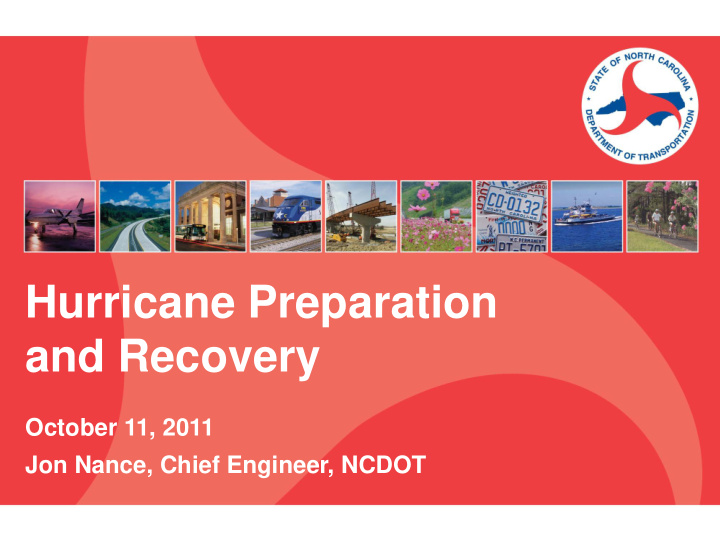



Hurricane Preparation and Recovery October 11, 2011 Jon Nance, Chief Engineer, NCDOT
Hurricane Preparation and Recovery North Carolina & Severe Weather Our state often bears the brunt of storms, which include: • Ice storms • Snow storms • Heavy rain and flooding • Hurricanes • Tornadoes
Hurricane Preparation and Recovery NCDOT Mission During disasters, NCDOT is tasked with: • Maintaining all state-owned highways • Providing access for emergency personnel • Allowing egress to the public • Removing and disposing of vegetative debris along state maintained roadways
Hurricane Preparation and Recovery Hurricane Irene • Example of how NCDOT prepares and responds to disasters • Irene was predicted to hit as a Category 2 or 3 storm • Made landfall on Aug. 27 near Cape Lookout • Strong Category 1 • Left 6 people dead • Caused widespread flooding, damage
Hurricane Preparation and Recovery Pre-Hurricane Planning 5 Days Before Landfall: • National Weather Service begins sending detailed hurricane forecasts to NCDOT • NCDOT holds internal conference call • Divisions along the coast assess supplies • Coordination begins with NCEM, FEMA, FHWA • Staff participate in SERT
Hurricane Preparation and Recovery Pre-Hurricane Planning 3 Days Before Landfall: • Evacuations along Outer Banks begin • Highway Division coordinates with Ferry Division to move residents, visitors to safety • IMAP crews move from central NC to coast to guide evacuations • Hold conference calls with NWS to discuss: • Current storm track • Response plans for “hot spot” areas • Support from divisions not in storm’s path
Hurricane Preparation and Recovery Pre-Hurricane Planning 2 Days Before Landfall: • Do maintenance checks on equipment • Order supplies • Stockpile barricades and other materials • Fuel up equipment • Locate debris removal sites • Work with county emergency management officials on storm response, debris collection • Prepare debris removal contracts for bid after the storm
Hurricane Preparation and Recovery Pre-Hurricane Planning 1 Day Before Landfall: • Station equipment and staff along N.C. 12 for efficient storm response • Schedule shifts of crews to remove debris from high impact areas • Ready Ferry Division to activate emergency ferry route from Stumpy Point to Rodanthe • Continue holding conference calls with NWS to determine where hardest hit areas will be • Reinforce safety messages to field employees
Hurricane Preparation and Recovery Pre-Hurricane Planning Worked with NCDOT Communication Office to inform the public: • Sent news releases about preparations • Participated in media interviews • Sent tweets to thousands of followers • Posted photos to Flickr • Put updates on Secretary’s Facebook page • Offered real-time travel information on website • Produced video and posted to YouTube
Hurricane Preparation and Recovery Pre-Hurricane Response
Hurricane Preparation and Recovery Hurricane Response 24 Hours After Landfall: • Surveyed the damage from the storm on the ground • Photogrammetry took aerial photos of damage • Shared damage assessments with NCEM, FHWA, FEMA • Blocked off impassable roads • Inspected bridges • Began removing downed trees from roads • Moved 100+ maintenance workers from unaffected divisions to coast to help with debris removal
Hurricane Preparation and Recovery Hurricane Response 48 Hours After Landfall: • Hydraulics experts flew via helicopter to damaged areas to gather data • Survey experts collected data • Assisted county emergency management with recovery options • Launched contracts to begin debris removal, road repair • Reopened roads and bridges as flooding subsided and debris removed • Established debris collection schedules
Hurricane Preparation and Recovery N.C. 12 Response, Recovery • Closed road to traffic • Hosted merger team on Aug. 31 to discuss data collected • Finalized design criteria for temporary solution • Completed design on Sept. 1 for temporary bridge • Obtained all permits for temporary bridge and secured contractors on Sept. 2 • Started work in Rodanthe on Sept. 2 • Began construction on temporary bridge on Sept. 8 • Bridge, N.C. 12 open to traffic on Oct. 10
Hurricane Preparation and Recovery Bonner Bridge Response • Prior to Irene’s landfall, survey experts took measurements • Immediately after the storm hit, engineers visually inspected the bridge and found no signs of damage • Bridge divers conducted underwater inspections and found no storm damage • Survey experts took additional measurements and found no significant change • Bridge remained closed until N.C. 12 repairs were completed Oct. 10 • Construction on new bridge to start in late 2012
Hurricane Preparation and Recovery Hurricane Response Worked with the NCDOT Communications Office to inform the public: • Sent daily news releases regarding progress on N.C. 12 recovery efforts • Sent regular news releases about road conditions, debris collection • Created N.C. 12 website and blog to chart progress • Posted photos of storm damage to Flickr • Tweeted travel updates, ferry information, road condition details to thousands of followers • Answered citizens’ storm -related questions on Secretary’s Facebook page • Produced videos on recovery efforts
Hurricane Preparation and Recovery Hurricane Response
Hurricane Preparation and Recovery Local Government Involvement Memorandums of Agreement: • Releases NCDOT authority to local government • Allows local government to be reimbursed by FEMA • Allows local government to immediately begin removing debris on secondary routes • Primary routes are not immediately eligible
Hurricane Preparation and Recovery Reimbursements FEMA: • Disaster threshold is $12.5 million statewide • Each county must be declared individually • Individual and public assistance are separate declarations • 4 categories of work: • Category A — Debris Removal • Category B — Emergency Protective Measures • Category C — Roads and Bridges • Category E — Buildings and Equipment FHWA: • Disaster threshold is $700,000 statewide • Once a declaration is made all counties are eligible • Emergency Protective Measures are not eligible • FHWA only recognized NCDOT as an applicant
Hurricane Preparation and Recovery Questions?
Recommend
More recommend